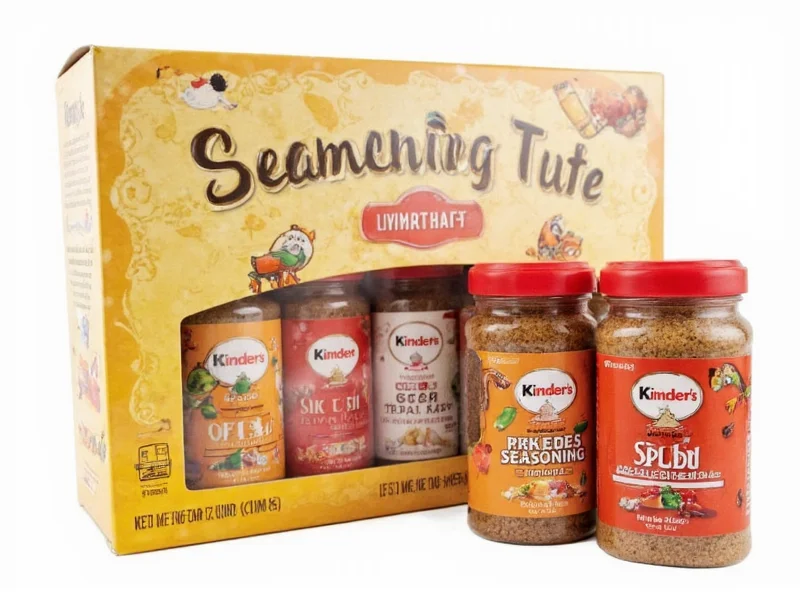For home cooks seeking authentic Texas barbecue flavors, Kinder's seasoning set offers a professional-grade solution that bridges the gap between restaurant-quality results and backyard cooking. The carefully balanced blends in this collection have been perfected over decades of operation at Kinder's Barbeque, a family-owned establishment that began as a single meat market in Katy, Texas and has grown into a regional institution known for its commitment to quality and tradition.
Components of the Standard Kinder's Seasoning Collection
Understanding what makes Kinder's seasoning set special begins with examining its individual components. Each seasoning serves a specific culinary purpose while maintaining the distinctive flavor profile that defines Kinder's approach to barbecue.
| Seasoning Type | Primary Flavor Profile | Best Applications | Key Ingredients |
|---|---|---|---|
| Original Seasoning | Balanced savory with subtle sweetness | Brisket, pork ribs, chicken | Salt, black pepper, garlic, onion, paprika, sugar |
| Spicy Seasoning | Robust heat with smoky undertones | Beef ribs, sausage, pulled pork | Salt, cayenne, black pepper, garlic, onion, chili powder, cumin |
| Coffee Rub | Rich depth with earthy notes | Brisket, short ribs, steak | Coffee, salt, brown sugar, smoked paprika, garlic, onion, cocoa powder |
Practical Applications for Home Cooks
When using Kinder's seasoning set effectively, proper application technique matters as much as the seasoning itself. For optimal results with kinder's seasoning set for brisket, apply generously 1-2 hours before cooking to allow the flavors to penetrate the meat. The salt content in these seasonings helps form a desirable bark during the smoking process, a critical element in Texas-style barbecue.
One common question is how to use kinder's barbecue rub set on different proteins. For chicken, use a lighter application of the Original Seasoning to avoid overpowering the delicate meat. When working with kinder's spicy seasoning vs original, remember that the spicy variant contains additional heat elements that complement fattier cuts of meat which can handle more aggressive seasoning.
Storage and Shelf Life Considerations
Proper storage significantly impacts the longevity and effectiveness of your kinder's seasoning collection. These seasonings maintain optimal flavor for 18-24 months when stored correctly. To maximize shelf life:
- Keep containers tightly sealed when not in use
- Store in a cool, dark place away from heat sources
- Avoid introducing moisture to the containers
- Don't store directly above your stove or oven
Unlike many commercial seasoning blends, Kinder's products contain no anti-caking agents, which means proper storage is essential to prevent clumping. If your kinder's original seasoning ingredients begin to clump, this indicates moisture exposure rather than product degradation.
Comparing Kinder's to Alternative Seasoning Options
When evaluating kinder's seasoning set alternatives, several factors distinguish this collection from generic supermarket options. The absence of MSG, artificial flavors, and fillers creates a cleaner flavor profile that allows the natural meat flavors to shine through. While many commercial rubs rely heavily on sugar for quick caramelization, Kinder's formulations balance sweetness with savory elements for more complex flavor development during the slow cooking process.
Home barbecue enthusiasts often ask about best kinder's seasoning set uses beyond traditional meats. The Original Seasoning works surprisingly well as a seasoning for roasted vegetables, while the Coffee Rub adds depth to chocolate-based desserts. This versatility makes the collection valuable for more than just barbecue applications.
Practical Tips for Maximizing Flavor
For those wondering how to store kinder's seasoning properly, consider transferring the seasonings to airtight glass containers if you plan to keep them long-term. The original packaging, while convenient, isn't designed for extended storage. When applying the rubs, use the "hand test" method—apply enough that you can still see the meat's surface through the seasoning layer.
Many home cooks don't realize that the timing of application affects results. For best outcomes with kinder's seasoning set for ribs, apply the rub and refrigerate the meat uncovered for several hours or overnight. This dry-brining technique enhances both flavor penetration and bark formation during cooking.
Frequently Asked Questions
What makes Kinder's seasoning set different from other barbecue rubs?
Kinder's seasoning set stands out due to its restaurant-developed formulations that have been refined over decades of operation. Unlike many commercial rubs, Kinder's products contain no MSG, artificial flavors, or fillers. The balance of salt, pepper, and supporting spices creates a versatile profile that enhances rather than overwhelms the natural meat flavors. The seasonings are designed specifically for the low-and-slow barbecue cooking method that defines Texas-style barbecue.
Can I use Kinder's seasoning set for dishes beyond barbecue?
Absolutely. While designed for barbecue applications, Kinder's seasonings have versatile uses. The Original Seasoning works well as a general-purpose seasoning for roasted vegetables, potatoes, and even popcorn. The Coffee Rub adds depth to chocolate desserts and can be used in chili recipes. Many home cooks also use the Spicy Seasoning as a flavorful addition to homemade soups and stews for an extra dimension of flavor.
How much seasoning should I use per pound of meat?
For optimal results, use approximately 1 tablespoon of Kinder's seasoning per pound of meat. The exact amount can vary based on personal preference and the specific cut. For larger cuts like brisket that will be cooked for many hours, you can be more generous with the application. For quicker-cooking items like chicken breasts, use a lighter hand. Remember that the seasoning should form a thin, even layer where you can still see the meat's surface beneath the rub.
Are Kinder's seasonings gluten-free and suitable for special diets?
Yes, all seasonings in the Kinder's seasoning set are naturally gluten-free, contain no artificial preservatives, and are suitable for most dietary restrictions. They are also free from common allergens beyond what's listed in the ingredients. However, as with any packaged food product, those with severe allergies should verify the current ingredient list as formulations can occasionally change. The seasonings are also compatible with keto and paleo diets due to their simple ingredient profiles.











 浙公网安备
33010002000092号
浙公网安备
33010002000092号 浙B2-20120091-4
浙B2-20120091-4